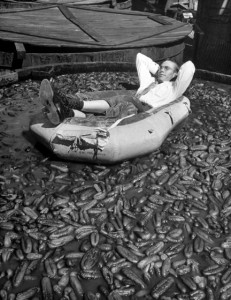SOUTH TAMPA — Two Tampa natives have a new take on the can-do spirit.
Marte Watson and her son, Armin, pamper Mother Nature’s colorful palate of produce from garden to jars within days. Their company, Watson Kitchen, turns out shimmering jams, robust spicy dilly beans, tangy green tomato pickles and more.
Named for Marte’s father, Red Hall, Pappy’s Creole Sauce is a scarlet-red tomato sauce simmered with homemade chicken stock, fresh tomatoes, onions, peppers and celery. When teamed with shrimp and rice, it’s a lickety-split-fast Southern entree. The sauce pairs with sausage and chicken, as well.
“We wanted to start a business that incorporated our love of cooking and Florida food,” said Marte, a retired high school English teacher.
The pickling pros start by choosing quality ingredients from local farmers markets. Next comes long hours spent preparing and processing, and finally, hand bottling the small batches for the best flavor. A day’s work triumphs in 100 jars of Pappy’s sauce or 160 jars of jam.
“Although we can’t use fresh Florida all year, at least 75 percent of our products are strictly locally grown,” said Armin.
Their labor-intensive craft singles them out as the only hand bottlers in their own commercial kitchen in Tampa, he added.
His father, contractor Jimmy Watson, put the finishing touches to an old house in Drew Park to create their spotless canning facility.
Before they got Pappy’s sauce off and running, they processed mango-jalapeno, strawberry-jalapeno and blueberry-jalapeno jams.
“To bring in a bit of cash,” Armin said.
The fruits have natural acid and can be canned easily as a “cottage industry” that can be sold at farmer’s markets.
“It’s been a lot of trial and error,” said Armin with a laugh, about the steep learning curve they went through to get Food and Drug Administration approval.
The duo credit UF/IFAS Hillsborough food extension agent Mary Keith for demystifying the preserving process and teaching them invaluable tips. Keith provided a road map to begin their journey.
Friends also stepped up as taste testers, eating “more shrimp Creole in one year than most had eaten in their lifetimes,” said Marte, who kept meticulous notes to create their final, Blue Ribbon-worthy recipe.
Jessica Moore, general manager of Duckwood Urban Market, applauds the Watson family and their products.
“First and foremost, they are delicious; we focus on locally-made products, and they are such nice people,” said Moore.
People like to look back in time and pickling has come back in style, she said.
When Moore puts out the Watson’s products for sampling, tasters become customers.
Shoppers can also sample their line themselves on Friday 9 a.m. to 4 p.m. at the Tampa Garden Club Garden Fest & Holiday Market and on Tuesday 1-8 p.m. at the Annual Holiday Shopping Event at the Tampa Museum of Tampa.
Spicy Dilly Beans are Armin’s favorite product to make. The 5-calorie snacks work as Bloody Mary stirrers having a flavorful crunch of dill.
Green Tomato Pickles punch up salsa, salads, turkey sandwiches and burgers.
“Their products sell very, very, very well,” said Tina Mastrona of Bayshore Market. “I have people come in and buy six or seven jams or Creole sauces at a time.”
The Watsons also give back to the community. Leftover produce is given to Bethesda Ministries in Tampa, whose the mission is to help the disadvantaged become more self-sufficient.
Marte reflects on the business as having a few growing pains along the way but believes theirs is “up and coming.” The Watsons hopes to expand their line.
For information on the company, or to enjoy their cache of canned holiday shopping options, visit www.watsonkitchen.com.

